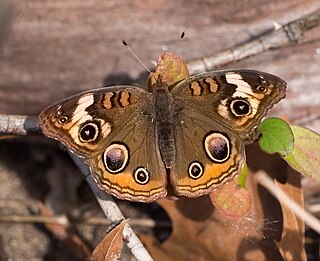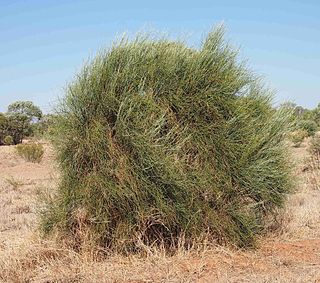
The large blue is a species of butterfly in the family Lycaenidae. The species was first defined in 1758 and first recorded in Britain in 1795. In 1979 the species became mostly extinct in Britain but has been successfully reintroduced with new conservation methods. The species is classified as "near threatened" on the IUCN Red List of Threatened Species. Today P. arion can be found in Europe, the Caucasus, Armenia, western Siberia, Altai, north-western Kazakhstan and Sichuan.

The common blue butterfly or European common blue is a butterfly in the family Lycaenidae and subfamily Polyommatinae. The butterfly is found throughout the Palearctic. Butterflies in the Polyommatinae are collectively called blues, from the coloring of the wings. Common blue males usually have wings that are blue above with a black-brown border and a white fringe. The females are usually brown above with a blue dusting and orange spots.

The dorcas gazelle, also known as the ariel gazelle, is a small and common gazelle. The dorcas gazelle stands about 55–65 cm at the shoulder, with a head and body length of 90–110 cm and a weight of 15–20 kg. The numerous subspecies survive on vegetation in grassland, steppe, wadis, mountain desert and in semidesert climates of Africa and Arabia. About 35,000–40,000 exist in the wild.

Junonia coenia, known as the common buckeye or buckeye, is a butterfly in the family Nymphalidae. It is found in the United States east of the Rocky Mountains and in Mexico. Its habitat is open areas with low vegetation and some bare ground. Its original ancestry has been traced to Africa, which then experiences divergence in Asia. The species Junonia grisea, the gray buckeye, is found west of the Rocky Mountains and was formerly a subspecies of Junonia coenia.

Pyrgus malvae, the grizzled skipper, is a butterfly species from the family Hesperiidae. It is a small skipper (butterfly) with a chequered pattern on its wings that appears to be black and white. This butterfly can be found throughout Europe and is common in central and southern regions of England. The butterfly prefers three major types of habitat: woodland, grassland, and industrial. Referenced as a superspecies, Pyrgus malvae includes three semispecies: malvae, malvoides, and melotis. Eggs are laid on plants that will provide warmth and proper nutrition for development. As larvae, their movement is usually restricted to a single plant, on which they will build tents, unless they move onto a second host plant. Larvae then spin cocoons, usually on the last host plant they have occupied, where they remain until spring. Upon emerging as adult butterflies, grizzled skippers are quite active during the day and tend to favour blue or violet-coloured plants for food. They also possess multiple methods of communication; for example, vibrations are used to communicate with ants, and chemical secretions play a role in mating. Exhibiting territorial behaviour, males apply perching and patrolling strategies to mate with a desired female.

The Karner blue is an endangered subspecies of small blue butterfly found in some Great Lakes states, small areas of New Jersey, the Capital District region of New York, and southern New Hampshire, where it is the official state butterfly. The butterfly, whose life cycle depends on the wild blue lupine flower, was classified as an endangered species in the United States in 1992.

The silver-studded blue is a butterfly in the family Lycaenidae. It has bright blue wings rimmed in black with white edges and silver spots on its hindwings, lending it the name of the silver-studded blue. P. argus can be found across Europe and east across the Palearctic, but is most often studied in the United Kingdom in which the species has experienced a severe decline in population due to habitat loss and fragmentation.

The chalkhill blue is a butterfly in the family Lycaenidae. It is a small butterfly that can be found throughout the Palearctic realm, where it occurs primarily in grasslands rich in chalk. Males have a pale blue colour, while females are dark brown. Both have chequered fringes around their wings.

The marsh fritillary is a butterfly of the family Nymphalidae. Commonly distributed in the Palearctic region, the marsh fritillary's common name derives from one of its several habitats, marshland. The prolonged larval stage lasts for approximately seven to eight months and includes a period of hibernation over the winter. The larvae are dependent on the host food plant Succisa pratensis not only for feeding but also for hibernation, because silken webs are formed on the host plant as the gregarious larvae enter hibernation. Females lay eggs in batches on the host plant and are, like other batch-layers, selective about the location of oviposition because offspring survivorship levels for batch-layers are more tied to location selection than they are for single-egg layers.

Orachrysops niobe, the Brenton blue, is a species of butterfly in the family Lycaenidae and is endemic to South Africa.

The Uncompahgre fritillarybutterfly is a species of butterfly in the Order Lepidoptera: Family Nymphalidae that is endemic to Colorado, USA.

Jalmenus evagoras, the imperial hairstreak, imperial blue, or common imperial blue, is a small, metallic blue butterfly of the family Lycaenidae. It is commonly found in eastern coastal regions of Australia. This species is notable for its unique mutualism with ants of the genus Iridomyrmex. The ants provide protection for juveniles and cues for adult mating behavior. They are compensated with food secreted from J. evagoras larvae. The ants greatly enhance the survival and reproductive success of the butterflies. J. evagoras lives and feeds on Acacia plants, so butterfly populations are localized to areas with preferred species of both host plants and ants.

Pseudophilotes baton, the baton blue, is a butterfly of the family Lycaenidae. It is found in central and southern Europe and then east across the Palearctic to the Russian Far East.
Grazing pressure is defined as the number of grazing animals of a specified class per unit weight of herbage. It is well established in general usage.

Saint Catherine is a city in the South Sinai Governorate of Egypt, at the foot of Mount Sinai. The city is famous for being the site of Saint Catherine's Monastery. The city is located 1,586 metres (5,203 ft) above sea level and is 120 kilometres (75 mi) away from Nuweiba. In 1994, its population was 4,603 people. The Saint Catherine area is a UNESCO world heritage site, officially declared as such in 2002.

Nekhel is the capital of Nekhel Municipality of North Sinai Governorate, Sinai, Egypt. It is located in the heart of Sinai Peninsula along the southern border of North Sinai Governorate with South Sinai Governorate. It is located at the skirts of El Tih Mountains and foothills at an elevation of 420.6 m (1,380 ft). Coordinates of the city is 29°54'N; 33°45'E. Nekhel city is divided into 10 Markazes: Ras Naqb, Contilla, Sedr Elhitan, Tamd, Bir Grid, Khafga, Boruk, Netila, Ein Twibah and Assalam.

Apophyllum is a genus of plant native to Australia. It contains only one species, which by definition makes the genus a monotypic genus. This single species is called Apophyllum anomalum, commonly called warrior bush or broom bush.

The fiery copper or dull copper is an endemic Australian butterfly of the family Lycaenidae. One of the two subspecies, P. p. lucida, is commonly known as the Eltham copper.

Pseudophilotes bavius, the Bavius blue, is a butterfly of the family Lycaenidae. It is found in Morocco, Algeria, Bulgaria, Romania, Greece, Asia Minor, southern Russia and northern Kazakhstan. The species occurs in small isolated populations on flower-rich, dry grassland, on dry, stony slopes and on open patches in shrub and in vineyards on calcareous soil.


















